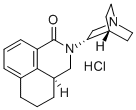Description
Palonosetron is a novel 5-HT3 receptor antagonist launched as an injectable
agent for the prevention of acute and delayed nausea and vomiting associated with
cancer chemotherapy. It has a much longer half-life (~ 40 h) than the other currently
available 5-HT3 antagonists, which provides efficacy advantages in the prevention of
delayed nausea and vomiting that typically occurs after 24 h and up to six days post
chemotherapy administration. Palonosetron was developed as a conformationally
restricted analog of the previously known 5HT3 antagonists tropisetron and
granisetron. It is synthesized in four steps starting with the condensation of 1,8-
naphthalic anhydride and (S)-3-aminoquinuclidine to produce the corresponding
imide. The subsequent steps include catalytic hydrogenation of one of the aromatic
rings of the imide intermediate, selective reduction of one of the carbonyls to a
hydroxyl group, dehydration to an olefin and catalytic hydrogenation. The
recommended dosage of palonosteron is 0.25 mg, administered as a single
intravenous dose approximately 30 min before the start of chemotherapy. Palonosetron
exhibits dose-proportional pharmacokinetics and it is moderately bound to
plasma proteins (62%). Fifty percent of the dose is metabolized in the liver, and 40%
is excreted unchanged in the urine. In comparative clinical studies with two other 5-
HT3 receptor antagonists, palonosetron is shown to be as effective as dolasetron and
more effective than ondansetron in controlling acute nausea and vomiting and
superior to both in the control of delayed nausea and vomiting. Efficacy of palonosetron has been demonstrated in patients receiving initial and repeat courses of
both moderately and highly emetogenic chemotherapy, including cisplatin, cyclophosphamide
and dacarbazine. At 0.25 and 0.75 mg doses, palonosetron is well tolerated
and the most occurring adverse events are headache, diarrhea, fatigue, abdominal
pain and insomnia.
Chemical Properties
White Solid
Originator
Syntex (Roche Bioscience) (US)
Uses
Palonosetron HCl is a 5-HT3 antagonist used in the prevention and treatment of chemotherapy-induced nausea and vomiting
Uses
Palonosetron is a potent, selective antagonist of the serotonin (5-HT) receptor 5-HT3 (pKi = 10.4 in rat cortex) that minimally effects a wide range of other neuronal receptors. It is orally bioavailable and potently inhibits emesis induced by chemotherapeutic drugs, like cisplatin , but not by apomorphine , which acts by dopamine receptor antagonism. Palonosetron is remarkable for its long duration of action, related to its high receptor-binding affinity and long half-life. It is effective in managing chemotherapy-induced nausea and vomiting.[Cayman Chemical]
Uses
Serotonin 5-HT3 receptor antagonist used in the prevention and treatment of chemotherapy-induced nausea and vomiting (CINV). Antiemetic.
Uses
specifically inhibits cells of the adrenal cortex and their production of hormones for adrenocortical tumor therapy, causes CNS damage, but no bone marrow depression.
Definition
ChEBI: A hydrochloride obtained by combining palonosetron with one molar equivalent of hydrogen chloride; an antiemetic used in combination with netupitant (under the trade name Akynzeo) to treat nausea and vomiting in patients undergoing cancer chemotherapy.
Brand name
Aloxi (Helsinn).
storage
4°C, protect from light
